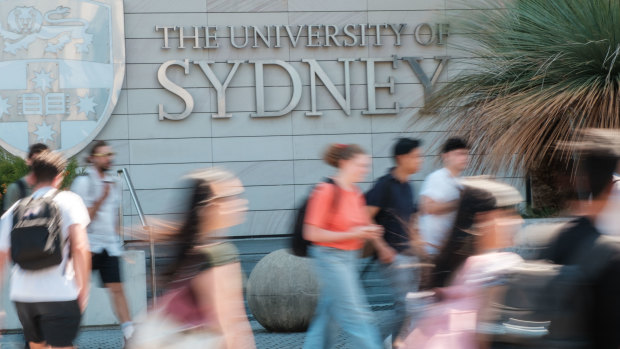This was published 1 year ago
Nation adds 1361 people a day as migrants swell population
By Shane Wright
Australia’s population swelled by a record 497,000 through 2022, driven by the nation’s single largest annual intake of migrants, even as COVID-19 infections lifted the number of deaths and weighed on natural growth.
Amid an ongoing political debate about the size of the population and pressure on the housing market, figures from the Australian Bureau of Statistics on Thursday revealed a net 387,000 migrants made their way into the country last year.

The return of international students has helped Australia record its largest annual increase in population.Credit: Oscar Colman
Almost 620,000 people arrived, while 232,600 departed.
Of the net migrant intake, 134,600 moved into NSW, with another 120,500 taking up residence in Victoria and 58,000 in Queensland.
The 387,000 easily exceeded the previous record of 315,000 set in 2008 when many Australians returned home as the global financial crisis wiped away millions of jobs across the United States and Europe.
The population grew by 1.9 per cent, its highest rate since 2008, with the nation’s population now at 26.3 million.
The bureau’s head of demography, Beidar Cho, said the closure of the border to deal with COVID-19 and its impact on international student numbers were key drivers of the large population increase.
“Recovery of international student arrivals is driving net overseas migration to historic highs, while departures are lagging behind levels typically seen over the past decade,” she said.
“This pattern is expected to continue as international students return following the reopening of international borders, however there are fewer students ready to depart because very few arrived during the pandemic.”
The government has come under attack from the Coalition since the May budget revealed the nation is expecting 1.5 million net migrants to call Australia home over the next five years. Opposition Leader Peter Dutton has accused the government of a “big Australia” policy that would increase cost-of-living pressures.
But the government has rejected the claims, arguing much of the increase is due to a catch-up caused by the border closure. The budget confirmed the nation’s population will be 700,000 smaller by the end of the decade compared to what had been forecast by the Coalition in its 2019 pre-COVID budget.
While net overseas migration surged, the natural increase in the population – births minus deaths – fell by 23.4 per cent on the December quarter of 2021.
In NSW alone, there was a 2500 drop in the natural increase while there was a 38 per cent fall in Western Australia. Victoria defied the trend with a 15 per cent lift.
Nationally, births fell by 4.6 per cent to 300,700 while deaths jumped by 11.1 per cent to a record 190,900.
The biggest increase in deaths in percentage terms occurred in the ACT, up by 16.2 per cent in 2022 compared to the previous year. By number, deaths were highest in NSW, where they jumped by 6533 (11.6 per cent), followed by Victoria (4949) and Queensland (4314).
Cho said COVID-related mortality was the main contributor to both the lift in deaths and the overall fall in the nation’s natural increase in population.
Through 2022, NSW added 138,000 residents, taking its population to 8.2 million. Victoria added a similar number with its population reaching 6.7 million while Queensland is now home to almost 5.4 million residents.
The fastest-growing state last year was WA, with its population up by 2.3 per cent, or 62,700, to 2.8 million.
The figures will be used by the Australian Electoral Commission to determine the number of federal seats in each state. Based on population movements, WA will gain a seat but both Victoria and NSW will lose an electorate in the run-up to the next election. The AEC will officially confirm a start to redistributions in each state next month, which will reduce the number of seats in the House of Representatives to 150.
Cut through the noise of federal politics with news, views and expert analysis from Jacqueline Maley. Subscribers can sign up to our weekly Inside Politics newsletter here.